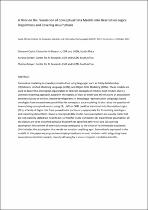 ResearchSpace
ResearchSpace
A note on the translation of conceptual data models into description logics: disjointness and covering assumptions
JavaScript is disabled for your browser. Some features of this site may not work without it.
- ResearchSpace
- →
- Research Publications/Outputs
- →
- Conference Publications
- →
- View Item
| dc.contributor.author |
Casini, G

|
|
| dc.contributor.author |
Gerber, A

|
|
| dc.contributor.author |
Meyer, T

|
|
| dc.date.accessioned | 2013-03-25T06:51:24Z | |
| dc.date.available | 2013-03-25T06:51:24Z | |
| dc.date.issued | 2012-10 | |
| dc.identifier.citation | Casini, G, Gerber, A and Meyer, T. 2012. A note on the translation of conceptual data models into description logics: disjointness and covering assumptions. South African Institute for Computer Scientists and Information Technologists (SAICSIT 2012), Centurion, 1-3 October 2012 | en_US |
| dc.identifier.isbn | 978-1-4503-1308-7 | |
| dc.identifier.uri | http://dl.acm.org/citation.cfm?id=2389839 | |
| dc.identifier.uri | http://www.cair.za.net/research/outputs/note-translation-conceptual-data-models-description-logics-disjointness-and | |
| dc.identifier.uri | http://hdl.handle.net/10204/6609 | |
| dc.description | Copyright: 2012 ACM. This is an ABSTRACT ONLY. | en_US |
| dc.description.abstract | Conceptual modeling is nowadays mostly done using languages such as Entity-Relationship (ER) Models, Unified Modeling Language (UML), and Object-Role Modeling (ORM). These models are used to depict the ontological organization of relevant concepts or entities. Such models share a common modeling approach, based on the notions of class or entity and the relations or associations between classes or entities. Recent developments in knowledge representation using logic-based ontologies have created new possibilities for conceptual data modeling. It also raises the question of how existing conceptual models using ER, UML or ORM could be translated into Description Logics (DLs), a family of logics that have proved to be particularly appropriate for formalizing ontologies and reasoning about them. Given a conceptual data model, two assumptions are usually made that are not explicitly stated but need to be clarified for its DL translation: (1) disjointness assumption: all the classes are to be assumed pairwise disjoint if not specified otherwise; and (2) covering assumption: the content of every class must correspond to the union of its immediate subclasses (this includes the assumption that we do not consider anything apart from what is expressed in the model). In this paper we propose two simple procedures to assist modelers with integrating these assumptions into their models, thereby allowing for a more complete translation into DLs. | en_US |
| dc.language.iso | en | en_US |
| dc.publisher | ACM | en_US |
| dc.relation.ispartofseries | Workflow;9899 | |
| dc.subject | Conceptual modeling | en_US |
| dc.subject | Conceptual data models | en_US |
| dc.subject | Description Logics | en_US |
| dc.subject | DLs | en_US |
| dc.subject | Unified Modeling Language | en_US |
| dc.subject | UML | en_US |
| dc.title | A note on the translation of conceptual data models into description logics: disjointness and covering assumptions | en_US |
| dc.type | Conference Presentation | en_US |
| dc.identifier.apacitation | Casini, G., Gerber, A., & Meyer, T. (2012). A note on the translation of conceptual data models into description logics: disjointness and covering assumptions. ACM. http://hdl.handle.net/10204/6609 | en_ZA |
| dc.identifier.chicagocitation | Casini, G, A Gerber, and T Meyer. "A note on the translation of conceptual data models into description logics: disjointness and covering assumptions." (2012): http://hdl.handle.net/10204/6609 | en_ZA |
| dc.identifier.vancouvercitation | Casini G, Gerber A, Meyer T, A note on the translation of conceptual data models into description logics: disjointness and covering assumptions; ACM; 2012. http://hdl.handle.net/10204/6609 . | en_ZA |
| dc.identifier.ris | TY - Conference Presentation AU - Casini, G AU - Gerber, A AU - Meyer, T AB - Conceptual modeling is nowadays mostly done using languages such as Entity-Relationship (ER) Models, Unified Modeling Language (UML), and Object-Role Modeling (ORM). These models are used to depict the ontological organization of relevant concepts or entities. Such models share a common modeling approach, based on the notions of class or entity and the relations or associations between classes or entities. Recent developments in knowledge representation using logic-based ontologies have created new possibilities for conceptual data modeling. It also raises the question of how existing conceptual models using ER, UML or ORM could be translated into Description Logics (DLs), a family of logics that have proved to be particularly appropriate for formalizing ontologies and reasoning about them. Given a conceptual data model, two assumptions are usually made that are not explicitly stated but need to be clarified for its DL translation: (1) disjointness assumption: all the classes are to be assumed pairwise disjoint if not specified otherwise; and (2) covering assumption: the content of every class must correspond to the union of its immediate subclasses (this includes the assumption that we do not consider anything apart from what is expressed in the model). In this paper we propose two simple procedures to assist modelers with integrating these assumptions into their models, thereby allowing for a more complete translation into DLs. DA - 2012-10 DB - ResearchSpace DP - CSIR KW - Conceptual modeling KW - Conceptual data models KW - Description Logics KW - DLs KW - Unified Modeling Language KW - UML LK - https://researchspace.csir.co.za PY - 2012 SM - 978-1-4503-1308-7 T1 - A note on the translation of conceptual data models into description logics: disjointness and covering assumptions TI - A note on the translation of conceptual data models into description logics: disjointness and covering assumptions UR - http://hdl.handle.net/10204/6609 ER - | en_ZA |





